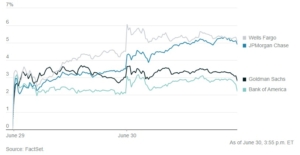Current Market Glossary (For Clients & Prospects)
What’s in Today’s Report:
- Current Market Glossary (For Clients & Prospects)
Futures are slightly lower following a night of disappointing tech earnings.
NFLX, TSLA and TSM all posted disappointing earnings results (stocks down 3% – 6% pre-market) and that’s weighing on Nasdaq and S&P 500 futures.
There was no notable economic data overnight.
Today will be another busy day of data and earnings results. On the economic front, the two key reports are Weekly Jobless Claims (E: 250k) and Philly Fed (E: -10.0), and as you can guess (and especially at these stretched valuations) markets will want to see more Goldilocks data (so stable claims and Philly and falling prices). We also get Existing Home Sales (E: 4.23M) but, barring a big miss, that shouldn’t move markets.
Turning to earnings, focus today is on industrials and consumer/healthcare names, and some important results to watch include: AAL ($1.58), TSM ($1.07), JNJ ($2.61), PM ($1.48), COF ($3.31), CSX ($0.49), and PPG ($2.14).

